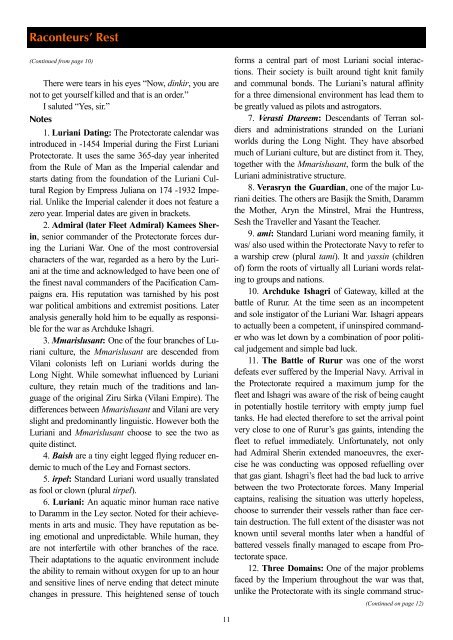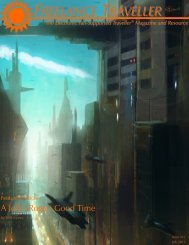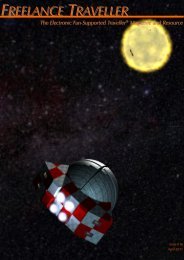ISO A4 format - Freelance Traveller
ISO A4 format - Freelance Traveller
ISO A4 format - Freelance Traveller
You also want an ePaper? Increase the reach of your titles
YUMPU automatically turns print PDFs into web optimized ePapers that Google loves.
Raconteurs’ Rest<br />
(Continued from page 10)<br />
There were tears in his eyes “Now, dinkir, you are<br />
not to get yourself killed and that is an order.”<br />
I saluted “Yes, sir.”<br />
Notes<br />
1. Luriani Dating: The Protectorate calendar was<br />
introduced in -1454 Imperial during the First Luriani<br />
Protectorate. It uses the same 365-day year inherited<br />
from the Rule of Man as the Imperial calendar and<br />
starts dating from the foundation of the Luriani Cultural<br />
Region by Empress Juliana on 174 -1932 Imperial.<br />
Unlike the Imperial calender it does not feature a<br />
zero year. Imperial dates are given in brackets.<br />
2. Admiral (later Fleet Admiral) Kamees Sherin,<br />
senior commander of the Protectorate forces during<br />
the Luriani War. One of the most controversial<br />
characters of the war, regarded as a hero by the Luriani<br />
at the time and acknowledged to have been one of<br />
the finest naval commanders of the Pacification Campaigns<br />
era. His reputation was tarnished by his post<br />
war political ambitions and extremist positions. Later<br />
analysis generally hold him to be equally as responsible<br />
for the war as Archduke Ishagri.<br />
3. Mmarislusant: One of the four branches of Luriani<br />
culture, the Mmarislusant are descended from<br />
Vilani colonists left on Luriani worlds during the<br />
Long Night. While somewhat influenced by Luriani<br />
culture, they retain much of the traditions and language<br />
of the original Ziru Sirka (Vilani Empire). The<br />
differences between Mmarislusant and Vilani are very<br />
slight and predominantly linguistic. However both the<br />
Luriani and Mmarislusant choose to see the two as<br />
quite distinct.<br />
4. Baish are a tiny eight legged flying reducer endemic<br />
to much of the Ley and Fornast sectors.<br />
5. irpel: Standard Luriani word usually translated<br />
as fool or clown (plural tirpel).<br />
6. Luriani: An aquatic minor human race native<br />
to Daramm in the Ley sector. Noted for their achievements<br />
in arts and music. They have reputation as being<br />
emotional and unpredictable. While human, they<br />
are not interfertile with other branches of the race.<br />
Their adaptations to the aquatic environment include<br />
the ability to remain without oxygen for up to an hour<br />
and sensitive lines of nerve ending that detect minute<br />
changes in pressure. This heightened sense of touch<br />
forms a central part of most Luriani social interactions.<br />
Their society is built around tight knit family<br />
and communal bonds. The Luriani’s natural affinity<br />
for a three dimensional environment has lead them to<br />
be greatly valued as pilots and astrogators.<br />
7. Verasti Dtareem: Descendants of Terran soldiers<br />
and administrations stranded on the Luriani<br />
worlds during the Long Night. They have absorbed<br />
much of Luriani culture, but are distinct from it. They,<br />
together with the Mmarislusant, form the bulk of the<br />
Luriani administrative structure.<br />
8. Verasryn the Guardian, one of the major Luriani<br />
deities. The others are Basijk the Smith, Daramm<br />
the Mother, Aryn the Minstrel, Mrai the Huntress,<br />
Sesh the <strong>Traveller</strong> and Yasant the Teacher.<br />
9. ami: Standard Luriani word meaning family, it<br />
was/ also used within the Protectorate Navy to refer to<br />
a warship crew (plural tami). It and yassin (children<br />
of) form the roots of virtually all Luriani words relating<br />
to groups and nations.<br />
10. Archduke Ishagri of Gateway, killed at the<br />
battle of Rurur. At the time seen as an incompetent<br />
and sole instigator of the Luriani War. Ishagri appears<br />
to actually been a competent, if uninspired commander<br />
who was let down by a combination of poor political<br />
judgement and simple bad luck.<br />
11. The Battle of Rurur was one of the worst<br />
defeats ever suffered by the Imperial Navy. Arrival in<br />
the Protectorate required a maximum jump for the<br />
fleet and Ishagri was aware of the risk of being caught<br />
in potentially hostile territory with empty jump fuel<br />
tanks. He had elected therefore to set the arrival point<br />
very close to one of Rurur’s gas gaints, intending the<br />
fleet to refuel immediately. Unfortunately, not only<br />
had Admiral Sherin extended manoeuvres, the exercise<br />
he was conducting was opposed refuelling over<br />
that gas giant. Ishagri’s fleet had the bad luck to arrive<br />
between the two Protectorate forces. Many Imperial<br />
captains, realising the situation was utterly hopeless,<br />
choose to surrender their vessels rather than face certain<br />
destruction. The full extent of the disaster was not<br />
known until several months later when a handful of<br />
battered vessels finally managed to escape from Protectorate<br />
space.<br />
12. Three Domains: One of the major problems<br />
faced by the Imperium throughout the war was that,<br />
unlike the Protectorate with its single command struc-<br />
(Continued on page 12)<br />
11

















